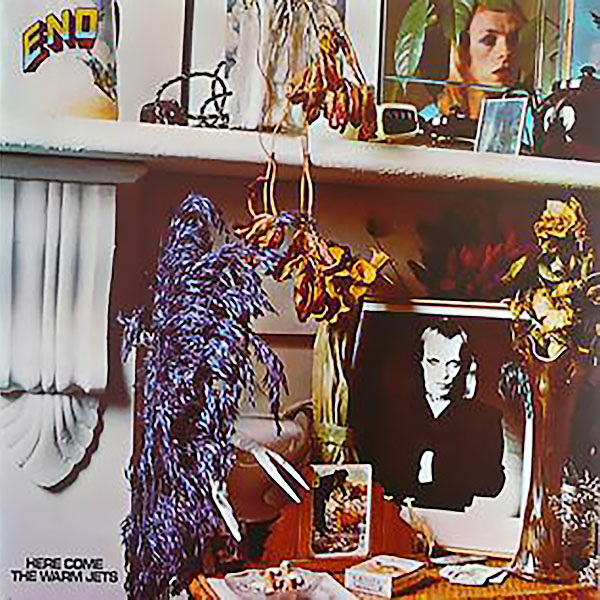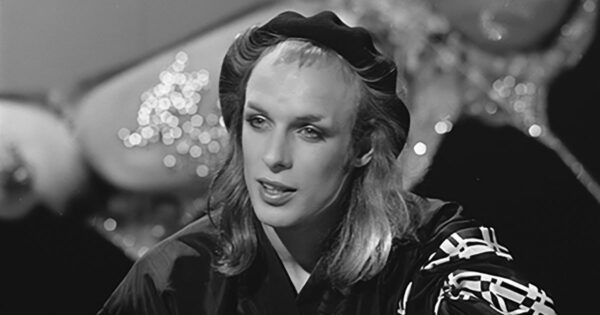Brian Eno's Audacious Debut, Here Come the Warm Jets, Turns 50: An Appreciation.
by John Diliberto
2/8/2024
 The first time I heard Brian Eno’s Here Come the Warm Jets I was home from college for a minute and early in the morning the local rock station, WBCN was playing the entire album. I put the headphones on and if I wasn’t awake when I started, I certainly was once the music came on. I’d known Eno’s work peripherally. He had been a member of Roxy Music, the pioneering British glam-rock act where Eno played synthesizer and processed the sounds of other band members. He left that group just as they were ascending after their second album. In 1973, he recorded No Pussyfooting with King Crimson guitarist Robert Fripp. It was in the mode of Terry Riley’s A Rainbow in Curved Air and would be the earliest sign of Eno’s Ambient music. It was also such a left turn from what his record company, Island records was expecting that they buried it. There was virtually no publicity, it came out as a low-priced budget release and didn’t come to the America until three years later. No one really heard about it and I picked it up as an experiment as an import at the Harvard Coop. I hadn’t heard Terry Riley yet and it blew my mind. But few others heard Eno and Fripp’s album.
The first time I heard Brian Eno’s Here Come the Warm Jets I was home from college for a minute and early in the morning the local rock station, WBCN was playing the entire album. I put the headphones on and if I wasn’t awake when I started, I certainly was once the music came on. I’d known Eno’s work peripherally. He had been a member of Roxy Music, the pioneering British glam-rock act where Eno played synthesizer and processed the sounds of other band members. He left that group just as they were ascending after their second album. In 1973, he recorded No Pussyfooting with King Crimson guitarist Robert Fripp. It was in the mode of Terry Riley’s A Rainbow in Curved Air and would be the earliest sign of Eno’s Ambient music. It was also such a left turn from what his record company, Island records was expecting that they buried it. There was virtually no publicity, it came out as a low-priced budget release and didn’t come to the America until three years later. No one really heard about it and I picked it up as an experiment as an import at the Harvard Coop. I hadn’t heard Terry Riley yet and it blew my mind. But few others heard Eno and Fripp’s album.
The label thought they were getting what they wanted with Here Come the Warm Jets. A nice pop album with hip credentials. But no. Here Come the Warm Jets was something else. It was an avant-garde album with pop dressing. And sonically, it was all over the place as Eno seemed to unleash every idea he had at once. There was the assaultive, strumming guitars of the opening track, “Needles in the Camel’s Eye” and the poignantly wistful reveries of tracks like “On Some Faraway Beach” and “Some of Them Are Old,” the later featuring Eno playing Hawaiian ukelele-like guitar, probably played slowly initially then sped up on tape. Some songs bleed in torment like “Driving Me Backwards”, a track that seems to be moving in multiple directions at once sonically, topped by some of Robert Fripp’s more tortured guitar work.
 Fripp was one of many associates that contributed to the album. Eno gathered in former Roxy bandmates Andy Mackay on saxophone and synth, Paul Thompson on drums and Phil Manzanera on guitar. There’s also bassists John Wetton (King Crimson, UK, Asia) and Bill MacCormick(Quiet Sun, Matching Mole, 801, Random Hold ) . He also recruited members of a band called Sharks with drummer Marty Simon, guitarist and session musician whiz Chris Spedding, keyboardist Nick Judd and bassist Busta “Cherry” Jones. Eno himself played Keyboards, synthesizer, snake guitar and electric larynx. Those last two you won’t find at Guitar Center, but were descriptions of the sounds Eno got. He also processed the other instruments.
Fripp was one of many associates that contributed to the album. Eno gathered in former Roxy bandmates Andy Mackay on saxophone and synth, Paul Thompson on drums and Phil Manzanera on guitar. There’s also bassists John Wetton (King Crimson, UK, Asia) and Bill MacCormick(Quiet Sun, Matching Mole, 801, Random Hold ) . He also recruited members of a band called Sharks with drummer Marty Simon, guitarist and session musician whiz Chris Spedding, keyboardist Nick Judd and bassist Busta “Cherry” Jones. Eno himself played Keyboards, synthesizer, snake guitar and electric larynx. Those last two you won’t find at Guitar Center, but were descriptions of the sounds Eno got. He also processed the other instruments.
Eno sang on all the songs. He was no Bryan Ferry, but had an energy and ironic sneer that carried his idiosyncratic compositions. Eno moved from the proto-punk of the aforementioned “Needles in the Camel’s Eye” to the nostalgic ’50’s sound of “Cindy Tells Me.” Eno could be anthemic and a downer at the same time. The title song has a surging synth and guitar track that seems to be driving toward Mach 10, but the lyrics are doom laden. Although they are buried in the mix, he’s singing “We’re down on our knees and we’ve nothing to say.” That’s how the album ends. The myth of the title is that warm jets is a slang term for urination, but in a 1996 interview with Mojo magazine, Eno said it was the description of the treated guitar sound on the track, “‘warm jet guitar’ … because the guitar sounded like a tuned jet.”
The track I always go to and cite on the album though is “Baby’s on Fire”. It is a blistering explosion th a non-stop rhythm from Simon King played mostly on high-hat and bass drum. Electronics swirl and squiggle through the track with Eno sneering out his story that is something of a commentary on media culture and celebrity as “photographer’s snip snap.” Then comes Robert Fripp’s tear-you-head-off guitar solo swirling through bends, feedback and distortion. Along with his work on David Bowie’s “Heroes” it’s Fripp’s best solo work outside of King Crimson.
Although Island records was hoping this would be a pop hit, it’s no surprise that it wasn’t. But it did get to #26 on the UK charts and #151 in Billboard. But critics like Lester Bangs and Robert Christgau loved it. 50 years later, it’s considered a signpost album of art rock. Here Come the Warm Jets is an all-out assault and the only hint of ambience is the distorted underwater bells drifting through the interlude between the last two tracks. No, not ambient. This is a PLAY IT LOUD release.
